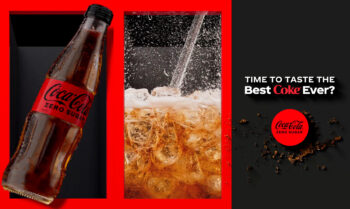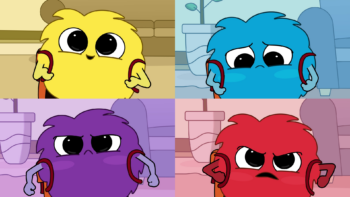
“Content is king!”
This is the declaration that you’ll hear many marketing and sales experts make.
But for me, having produced over a thousand videos for marketing, sales, training, and entertainment industries, behind this great King is a powerful Queen; the content’s presentation.
Truly great content will only be watched (or read) and appreciated if it is presented in a manner that people want to spend their precious attention span consuming.
How do we manipulate its presentation? Editing.
My name is Francis, I’m Creativa’s Video Producer, and in this post I’ll be sharing my top three personal learnings for editing great content with great style to make your video something someone appreciates spending their time on. At the end of this post I’ll do my best to reiterate my points by way of a short case study.
Tip #1: Why video length doesn’t (really) matter
One of the most frequently asked questions I get as a video editor is, “How long should a (insert type) video be?”
Well, how long is a piece of video?
The perception is that people’s attention spans in this modern era are short, so videos should be no more than 2 minutes. While I am not disputing that research, the reality is, if you think about the last time you watched a video online, what was the factor that made you watch it and keep watching it?
Engaging the viewer’s interest
Length could be a factor, but more likely? It’s interest. If you are interested in a topic, you will be willing to sit through a 15 minutes presentation and feel like it’s only 5 minutes. If you are not interested? Then even just 2 minutes will feel like an eternity.
The truth about the short attention span perception is that people will decide in the first 6 – 10 seconds whether they want to continue watching your video. Audiences channel surf or flick through YouTube, Instagram, TikTok for things they are interested in and if your video captures their attention in the first 6 – 10 seconds there is a much higher chance they decide to watch the rest of it.
Keeping the viewer’s interest
Here’s the situation; while length is a factor worth considering, we want to be focusing on engaging and keeping people’s interest. So the question is not so much ‘how long should my video be?’, but actually ‘what is the best way to share this message?’.
And further to that question, you’ll want to ask yourself:
- Do I really need [insert amount of time] to talk about the features and benefits, or can it be cut down into 3 minutes that highlight the key features, or benefits?
- If [insert amount of time] is required, then how can we style the information so that it’s new and fresh at every beat?
Of course, a lot of this planning and questioning will happen before the video is set for the shoot day, so in that case, I would recommend that you are involved somewhat in the process before the footage lands in your lap. It’s up to the whole production team and client working together to make sure that the final product is engaging and fit for purpose.
A successful and effective video edit links ideas and thoughts together in a fluent way so that the final video captures the imagination and attention of the viewer and holds them till the end of the video.

Tip #2: Content fluency
“Editing for me, going to watch a show, note to take like getting the right ideas, interest of the viewer first.”
Well, that was not a fluent sentence – for that matter, I don’t know if we could even call it a sentence! Which brings us to my learning to impart: make sure your content has fluency.
A solid video edit has a language and a flow
Your final edit has a story arc; an engaging introduction, an action packed middle, finished off with a ‘return to a better tomorrow’ ending. That is, the ending leaves the audience feeling that they are better off than where they started.
This flow should also be within each arc section of the video; that is, the intro should have a story arc by itself; and so too should the middle and the end.
By using this structure, you end up telling ‘mini’ stories. These ‘stories within a story’ flow from one to another and with the end of each part, the audience is ready to follow onto the next.
Regardless of whether your video is a product, training, or short film or sales campaign video, this language in editing will elevate your video from an information dump to a clear and concise call to action.
Remember, you are leading the audience to go from the status quo to a position where they feel like the world will be better at the end of the journey, all in incremental steps.

Tip #3: Music soothes the savage beast (so make sure you use it well!)
One of the first things that a person appreciates when watching anything is the sound they hear. The sound or music sets the mood for the video; it draws the viewer in and creates a soundscape that they can be caught up in.
Part of having good content fluency is ensuring the audio contributes to and enhances the whole experience.
Watch any movie, and about 95% of the time (just take my word for it!), you will hear something even before seeing the first visual. This music or soundscape is usually played under the studio logos before the first shot of the actual film even starts. But that music sets the scene for what is to come.
A good edit starts with knowing the soundtrack
Music cannot be dismissed as a secondary process in editing videos. In fact, my personal belief is that a good edit starts with knowing what soundtrack will go with it as well.
For me, even if I can’t figure out what music to use for a specific video or scene, I work with music beats in mind. The beats in my head help me tune in to how fast or slow the story should be, and why a visual is too long (or perhaps not long enough) to move the story forward.
Great music mixes and soundscapes are like the road that the story travels on. It may feel unimportant, but without the road, one can get lost because there are no roads to lead you home.

Coca Cola Christmas Case Study
Let’s look at this in action.
We’re going to look at the 2021 Coca Cola Christmas advertisement and try and catch where they’ve applied these learnings. This is a 2 minutes 33 seconds long (okay, it’s not that long) ad that feels like an epic film.
(This advertisement, by the way, really bucks the trend that tells you to keep your videos short!)
Give it a watch below.
Okay, now let’s break it down with what we’ve learnt. We’ll start with the three main sections, and then break those three down into beginning, middle and end.
The Beginning: A Lonely Old Woman on Christmas
It starts with a cold wintery soundscape accompanied by solemn music.
In the beginning of the beginning section of the video, the story introduces two lead characters, with focus on the boy.
The middle of the beginning scenes sets up the action (that he sees a lonely older lady in his apartment block), and the final part of the beginning sequences ends with him coming up with an idea to do something with a box – the call to action.
The Middle: Chimney Building Time
With the spark of this idea, the music changes to a more upbeat and faster paced jaunty tune, setting up the audience to expect some faster pace action and possibly some fun. Within this middle section, the story arc starts with the boy picking out items he needs for his ‘quest’.
This quest of his takes us to the middle part of the middle section. In his search for more boxes, he inspires first his mother, then the entire apartment resident to help out, and ends with the finishing touches of the long cardboard chimney being completed and lit up.
And for the end of the middle section? We (the audience) are left intrigued with the long cardboard chimney – what’s up with that?!
The Ending: All Ends Well on Christmas
The story ends with the music changing back to a warm and more peaceful tone. The arc of the end section starts with the boy going to sleep and a red present being dropped into the window of the old lady we saw earlier. A message in the box tells her to join a party at 3pm.
Now, we’re in the middle of the end, where everyone in the apartment block is on the roof sharing a celebratory party.
And the end o f the end? We see the boy sitting with the grumpy lady at the party – friends, by some Christmas miracle! And the call to action is clear – make Christmas magical, with Coca-Cola.
The Music Follows the Story Arc Too!
In fact if you listen to the music, it also follows the same overall story arc that the whole video has, it starts slow, builds up when the party is in action, and ends with a peaceful note at the end.
So, What Can We Learn from Coca-Cola?
You may say that this is an advertisement from a billion dollar company – and that trying to promote an event, or a product, create a training course, or inspire action in someone is a different beast entirely. Not to mention the different budgets we would be working with.
Well, richer companies have made worse ads. So, it’s not just about the production value or the budget – it’s also about the storytelling, and how the edits you make reflect the intention of the message, match the tone of the music and present the audience with an emotion that they can respond to – that keeps them watching.
Go forth and edit!
I hope this was an informative piece that has given you some insight into how to better edit your videos, and that you walk away (or close tabs away) and know that you can edit any product, service, training (and more!) video with engagement at the forefront, content fluency and a cohesive soundtrack – if you plan for it.
If you’re a video editor here to learn some more, I hope is that the tips I’ve given you in this post will help you on your next project.
And if you’re looking for a creative team who has gotten all this (and more) down pat, get in touch with our team – we’d love to work some magic with you.




